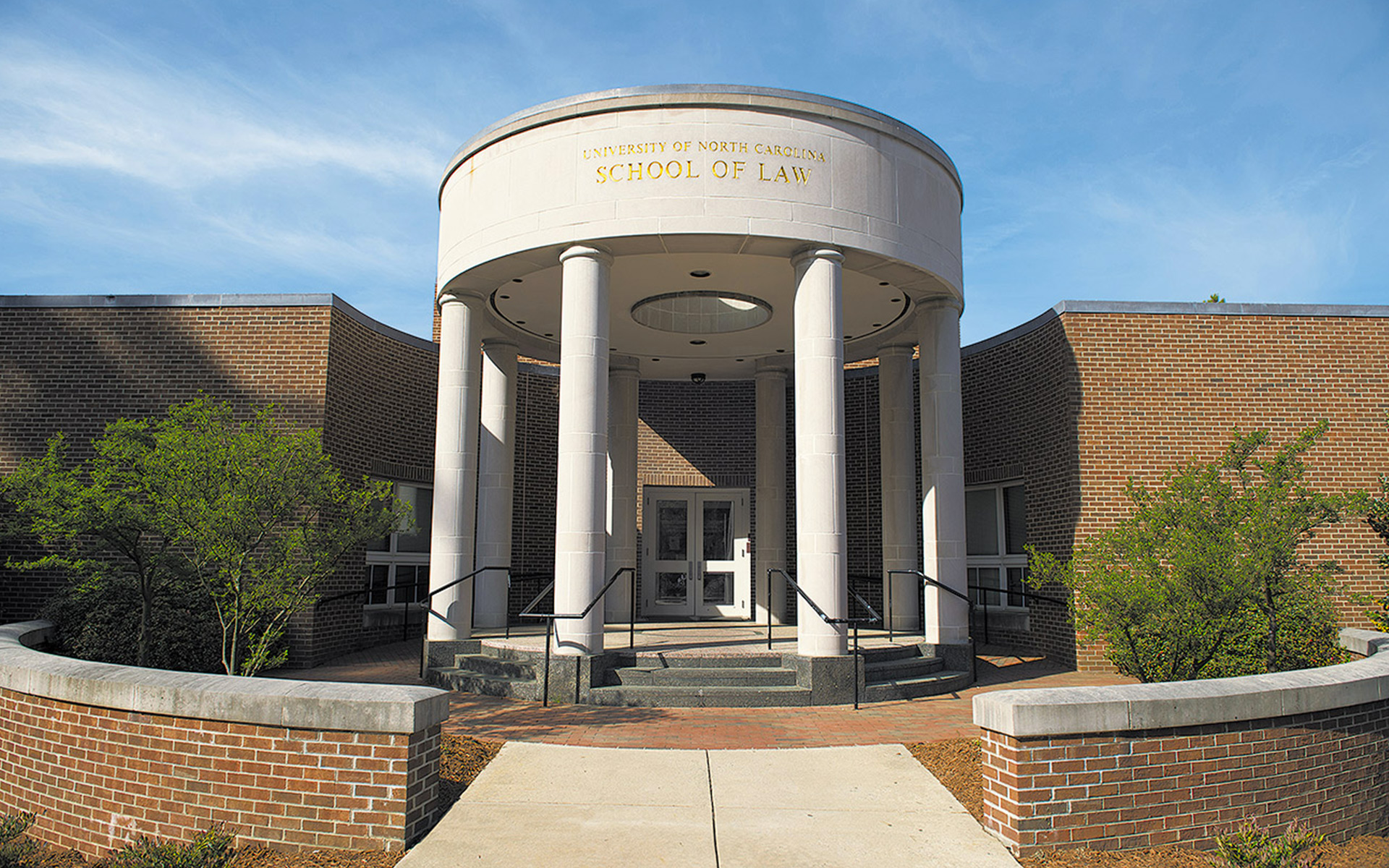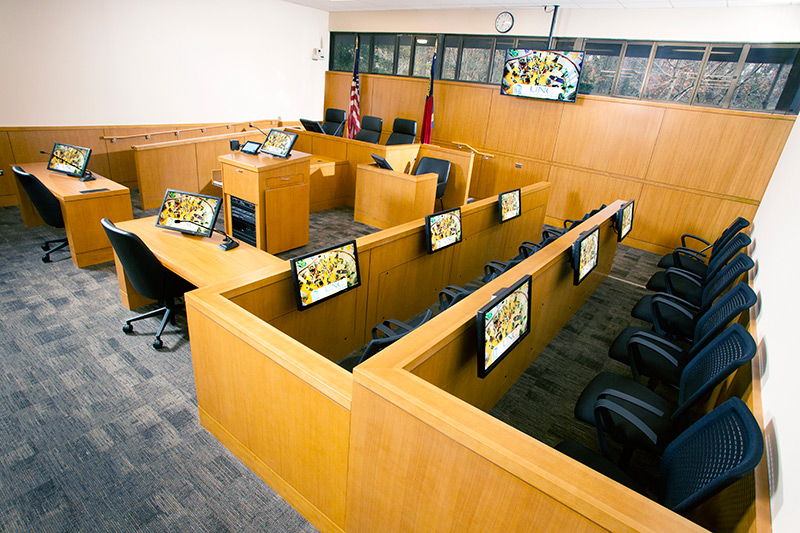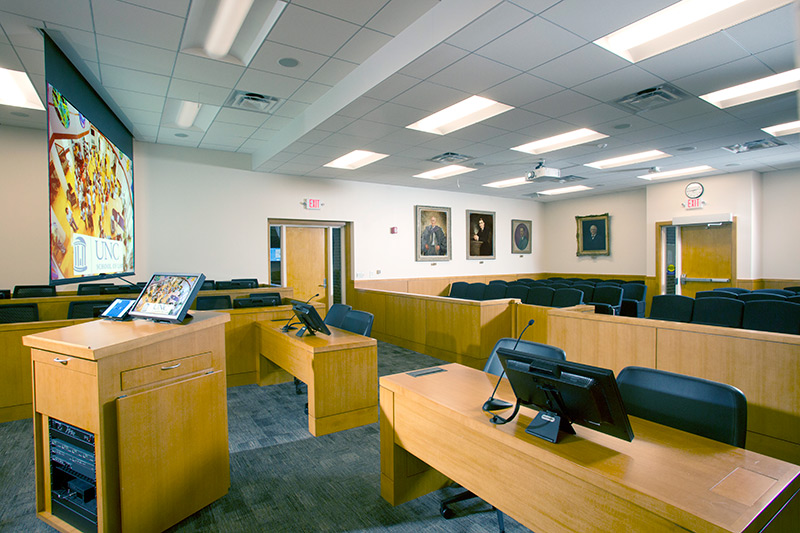
Extron XTP Systems and Annotator 300 Facilitate Courtroom Instruction at UNC School of Law
The UNC School of Law is part of the University of North Carolina at Chapel Hill. One of the valuable instructional activities at the school is moot court, which helps give Juris Doctor (JD) degree candidates realistic courtroom simulation experiences. From the moot courtroom’s construction in 1967 until the present, the room had not undergone major physical or technological renovations. To improve the moot court experience and classroom instruction, the UNC School of Law wanted a new, versatile AV system that would accommodate a range of sources, provide annotation capabilities for introducing evidence in simulated courtroom proceedings, and support moot courtroom or classroom modes. To provide these critical AV capabilities, integrator KONTEK Systems chose numerous Extron products including XTP Systems® and the Annotator 300.
We implemented the annotation capabilities in a way that precisely suited the needs of the users, making the Annotator 300 a very easy-to-use and powerful tool.
Billy Morris, Account Manager, KONTEK Systems
AV Needs and Challenges
One of the primary goals of the renovation was to provide AV capabilities that support simulated courtroom activities, as well as traditional single classroom instruction. Plans called for flexible AV switching between several sources and distribution to multiple display devices in the room. AV and control signals had to be extended as much as 80 to 150 feet between AV equipment at the defense and prosecution tables, lectern, judge’s bench, witness stand, and jury box. When the room was not in use for moot court sessions, it was also essential for an instructor at the lectern to be able to address students seated in the gallery, so the room could operate as a traditional classroom.
A challenge that KONTEK encountered during this new AV installation was the existing, original concrete flooring. It needed to be core drilled in order to run the AV cabling, so KONTEK sought a solution that would minimize the amount of drilling necessary. Twisted pair cabling would allow them to use multiple, smaller one-inch cores for conduit, rather than the larger cores that AV cabling typically passes through. Also, the current room layout presented sightline issues around the lectern where an attorney or instructor would be situated when addressing the judge’s bench or students in the gallery. This resulted in obstructed views for various participants. To address the sightline issue, KONTEK used an adjustable zero-profile mount on the lectern’s annotation monitor, and placed all other AV equipment out of view.
XTP System Provides Instructional Flexibility
KONTEK selected Extron XTP Systems to provide flexible AV switching and distribution in the moot courtroom, with a simplified cabling infrastructure. At the heart of the XTP System is an XTP CrossPoint 1600 modular 16x16 matrix switcher located in an equipment rack in the judge’s chamber. XTP transmitters and receivers located throughout the courtroom connect to the XTP matrix switcher over CAT 5e cable that carries audio and high resolution video. This helped to streamline the installation. The XTP CrossPoint 1600 also remotely powers the connected transmitters and receivers over the twisted pair cable, eliminating the need for local power at specific endpoints.
“The XTP System solution for AV distribution over twisted pair was the best fit for this project,” says Jeremy Shaffer, Design Engineer for KONTEK Systems. “The comprehensive initial training, combined with the many integrated capabilities of XTP reinforced the ease of use and benefits provided by this system.” Having already completed XTP Certification, KONTEK employees constructed the AV equipment racks and credenzas several days ahead of onsite field installation. This streamlined the project’s completion, despite the compressed project time frames and a field installation window of only two weeks from start to finish.
Sources in the courtroom include an installed Windows PC, laptops, a document camera at the lectern, and two high definition PTZ cameras that capture different views of the room. KONTEK installed Extron Cable Cubby 1200 Series/2 Cable Access Enclosures, featuring a slim profile, to provide convenient connectivity for AV sources and AC power at the defense and prosecution tables. During a moot court session, evidence is presented using flat-panel displays located at the defense and prosecution tables, the jury box, and a main display behind the witness stand for gallery viewing. When the room is used as a traditional classroom, an instructor has the ability to rotate the lectern to address students in the gallery space and use the room’s projector to display source content.
A combination of the XTP T UWP 202 NL two input wallplate transmitters and XTP T HDMI transmitters extend AV signals from laptops, the PC, and document camera to the XTP CrossPoint matrix switcher. The XTP transmitters addressed the need for high performance AV distribution from convenient locations. Additionally, KONTEK selected XTP SR HDMI scaling receivers to route video from the matrix switcher and ensure that video is shown at the opimal resolution for each display device. An HDMI DA6 distribution amplifier distributes one of the scaled XTP output signals to six additional displays in the jury box.
The XTP matrix switcher sends RS-232 signals from the control system to the XTP receivers over the CAT 5e cable, for controlling display devices. The ability to send control over the same twisted pair cable as video and audio greatly simplified cable management throughout the room.
“The XTP System operates smoothly and reliably, and its many features such as sending RS-232 and providing remote power over twisted pair cable, helped reduce installation time,” says Brian Peters, Lead Field Installer for KONTEK Systems. “XTP control passes through seamlessly under the hood, and the capability of the XTP CrossPoint to remotely power each of the XTP transmitters and receivers over twisted pair minimizes the footprint of the endpoints.”
Annotator 300 Enhances Simulation and Instruction
KONTEK chose the Extron Annotator 300 to provide instructors and moot court participants with annotation capabilities that are especially crucial when presenting or discussing evidence. The lectern, witness stand, and judge’s bench include touch displays that are connected to the Annotator 300 in the main equipment rack in the judge’s chamber, with Extron USB Extenders. Using the Annotator 300 and a connected touch display, an individual can make notations to computer-video presentations such as on a slide or document to clarify particular points and draw attention to different elements. In moot court, the collaborative annotation capability of the Annotator 300 allows the prosecutor to annotate evidence from the lectern while the witness annotates the same content simultaneously from the witness stand.
“The functional choice of the Annotator 300 came down to its controls — both for a user and for our programmers to control the product within the system,” says Billy Morris, Account Manager for KONTEK Systems. “We implemented the annotation capabilities in a way that precisely suited the needs of the users, making the Annotator 300 a very easy-to-use and powerful tool.”
The simultaneous video outputs of the Annotator 300 enable routing the same content through the XTP CrossPoint. One of the Annotator 300 outputs is configured as a Confidence output for displaying the built-in annotation GUI for the user, whereas the second Annotator 300 output is configured as a main output for audience viewing. This AV routing flexibility allows a presenter to annotate on any switched input source from the central XTP CrossPoint 1600, and provides flexibility for the user with the option to utilize three different annotation points. Through this system configuration, participants have a simplified view of just the annotated video content on the room’s other display devices. The ability to annotate electronic evidence for all parties to view simultaneously is an extremely powerful tool in evidence review, and a key part of court proceedings for trial lawyers.
The AV content, including annotated material, is sent to a lecture capture system, so that individuals can remotely view the lecture or mock trial for additional educational opportunities. The Annotator 300 also provides users with the option to capture and store annotated images to a removable USB flash drive, along with the ability to recall the annotated images. “The custom control interface we built for the UNC School of Law made the Annotator 300 invisible,” says Jonathan Danforth, Senior Programmer for KONTEK Systems. “Everything was routed automatically in the background, making source switching a completely transparent activity.”
Valuable Results
Using a combination of Extron XTP and annotation products, the installed AV system provides valuable AV capabilities that benefit all room users and participants. “The half dozen trial advocacy instructors are the heaviest users of the room, but since they’re adjunct professors, our group does not have much communication with them about their specific needs until right before they begin teaching,” says Charles Story, Classroom Technology and Multimedia Support Analyst at the UNC School of Law. “This new integrated system accommodated every need and function that they sought.”
With this flexibility, during times when the AV system is not needed, individuals can simply use the room as it is – no equipment needs to be relocated or moved aside for the room itself to function. When the AV is in use – with the room acting as a classroom or as a moot courtroom – the technology is not the focus of the room, but a seamless and indispensable part of the user’s session. “We’re here to train lawyers to practice law in the 21st century,” says Doug Edmunds, Assistant Dean for Information Technology at the UNC School of Law. “With the moot courtroom and its installed technology, we can now use our trial advocacy and moot court programs to do just that.”










 Chrome
Chrome
 Firefox
Firefox
 Edge
Edge
 Safari
Safari